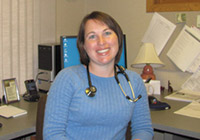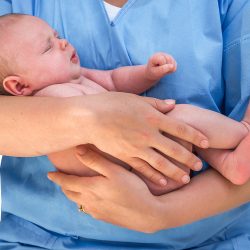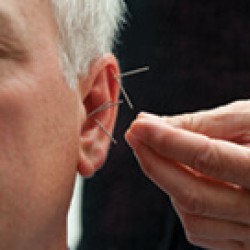The Art of Medicine

Erin Kimball, who today is a practicing family doctor in a small Wisconsin town, says choosing the rural track in medical school taught her “what it really means to be a physician.” Photo: Courtesy of Erin Kimball.
Erin Kimball ’03, MD’07 grew up in City Point, a township of 250 in central Wisconsin, where her family has lived for four generations. The nearest gas station was fifteen miles away; the closest school was twenty miles from her home. As a fourth-year medical student, she chose a rural track, and spent five months at the Krohn Clinic in Black River Falls, Wisconsin — population 3,800.
The track was a pilot effort for the Wisconsin Academy for Rural Medicine (WARM) at the University of Wisconsin School of Medicine and Public Health, a program designed to encourage young physicians such as Kimball to look seriously at rural practice.
“It was the best choice I made,” Kimball says. “Working with the doctors and nurses at the Krohn Clinic and Black River Memorial Hospital, I learned the art of medicine and what it really means to be a physician.” Today Kimball practices in Black Creek, Wisconsin, where she is the only family doctor in the town of 1,200.
The six sons of the late Paul Bishop ’43, MD’49 and his spouse, Alice, learned about that art firsthand from their father. They endowed the Dr. Paul R. and Alice P. Bishop Memorial Award to be presented annually to a third-year medical student enrolled in WARM. The sons — Neil, Edmund ’73, Paul, Mark MD’73, Alan ’78, and William — asked that preference be given to recipients who demonstrate a strong work ethic and compassion, and a willingness to go the extra mile for their patients.
Paul Bishop practiced first in Haynesville, Louisiana, before going into practice in Sauk Prairie, Wisconsin, with Gibbs Zauft ’46, MD’50. Bishop was well suited to rural doctoring, his son Neil says, noting, “I think he liked the small-town atmosphere because he was from a small town. I know he enjoyed the personal relationships that developed with his patients who were community people.”
In Louisiana, Bishop regularly made house calls. “I think he was one of the most conscientious people I’ve ever known in my life,” Neil says. Anytime anyone called, the question was not if the doctor would go, but how soon. Many of Neil’s driving lessons occurred taking his dad on house calls.
“I never saw him ever begrudge going to see someone,” Neil says. A rural Louisiana woman called about her mother every Sunday, he remembers. “Mama’s not feeling well,” she’d say. “You’d better come out.” So Neil would drive his dad to the family home, where he was always treated to a heaping plate of food while the doctor visited his patient.
Paul’s son Mark also is a family doctor, practicing in Mineral Point, Wisconsin. When Mark was in third grade, his classmates chose historical figures such as George Washington when assigned to write about the person they most admired. “I wrote about my dad,” he says. “I saw that, as a result of his life, he had a significant impact on the lives of others, and I wanted my life to count as much.
“We need more family physicians,” Mark adds. “Every single patient needs to have a family doctor, someone who’s looking at the entire context of their life.”
WARM was established to ensure that rural communities continue to have access to local physicians. Studies show rural patients are often sicker, poorer, older, and more likely to be uninsured, and the nation is facing a growing shortage of rural practitioners, says Byron Crouse, associate dean for rural and community health and WARM director. The WARM curriculum emphasizes rural public health and medical issues during the first two years of training, and allows students to complete most of their third- and fourth-year clinical training in rural communities. The program will graduate twenty-five rural physicians each year by 2015.
“By having students live in rural communities, they see the quality of life that can be so desirable,” Crouse says.
Kimball says the rural rotation gave her a strong foundation for everything she’s learned since then. “Whenever I have the chance, I encourage young medical students to spend as much time in smaller hospitals and clinics as they can,” she says.
To learn more about WARM or to make a gift online, visit med.wisc.edu/warm.
Published in the Winter 2010 issue



Comments
No comments posted yet.